#santa cruz basin
Text

Sometimes when I'm birdwatching
#sometimes when i’m birdwatching#things that aren’t birds#short-beaked common dolphin#dolphin#santa cruz basin
15 notes
·
View notes
Text
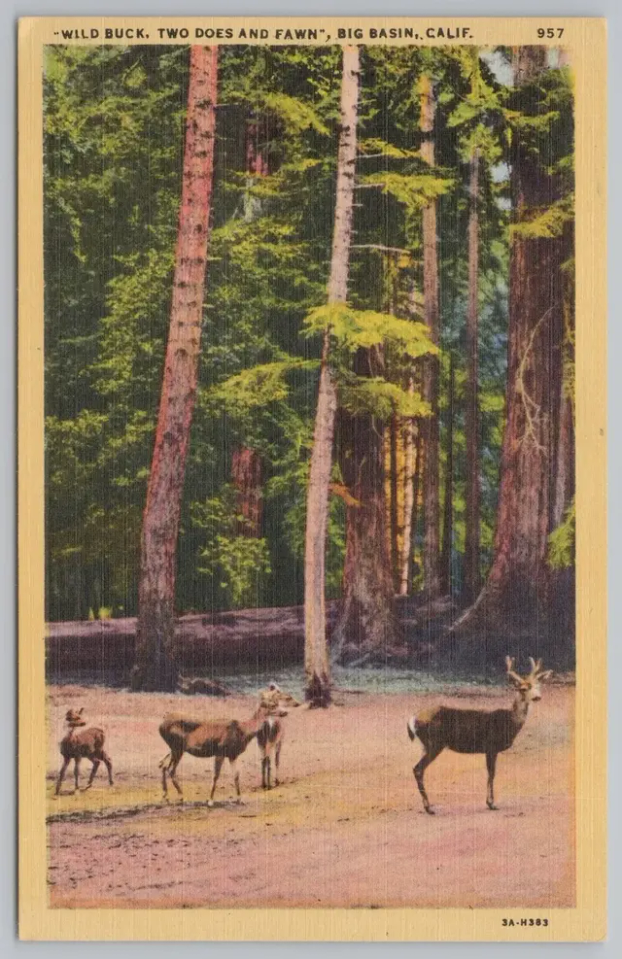
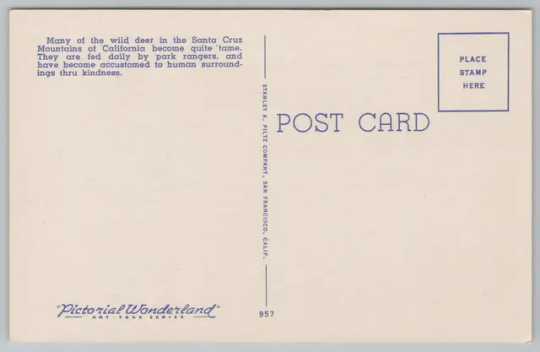
"Wild Buck, Two Does and Fawn", Big Basin, Calif.
Vintage Linen-Type Postcard, Pictorial Wonderland Art-Tone Series; Stanley A. Plitz Company circa. 1930-50s.
(please do not feed the wildlife.)
#California#redwoods#black tailed deer#deer#landscape#vintage art#postcard#lithograph#vintage illustration#big basin#forest#animals#history#california history#state parks#santa cruz#this was on a very weird fashy blog so i found a better image and provided historical context and alt text#hope she cries lol
44 notes
·
View notes
Text
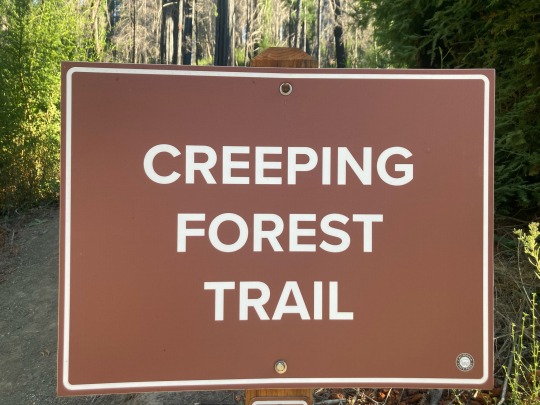
#actually I lied This is the last of the Woods Photos#this is where I blog from btw. the most ominously named trail possible#my photos#California#Santa Cruz County#Big Basin Redwoods State Park
14 notes
·
View notes
Text

2 notes
·
View notes
Text
Ancient redwoods recover from fire by sprouting 1000-year-old buds
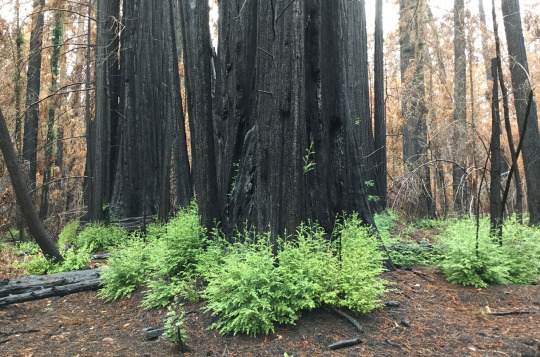
Article | Paywall free
When lightning ignited fires around California’s Big Basin Redwoods State Park north of Santa Cruz in August 2020, the blaze spread quickly. Redwoods naturally resist burning, but this time flames shot through the canopies of 100-meter-tall trees, incinerating the needles. “It was shocking,” says Drew Peltier, a tree ecophysiologist at Northern Arizona University. “It really seemed like most of the trees were going to die.”
Yet many of them lived. In a paper published yesterday in Nature Plants, Peltier and his colleagues help explain why: The charred survivors, despite being defoliated [aka losing all their needles], mobilized long-held energy reserves—sugars that had been made from sunlight decades earlier—and poured them into buds that had been lying dormant under the bark for centuries.
“This is one of those papers that challenges our previous knowledge on tree growth,” says Adrian Rocha, an ecosystem ecologist at the University of Notre Dame. “It is amazing to learn that carbon taken up decades ago can be used to sustain its growth into the future.” The findings suggest redwoods have the tools to cope with catastrophic fires driven by climate change, Rocha says. Still, it’s unclear whether the trees could withstand the regular infernos that might occur under a warmer climate regime.
Mild fires strike coastal redwood forests about every decade. The giant trees resist burning thanks to the bark, up to about 30 centimeters thick at the base, which contains tannic acids that retard flames. Their branches and needles are normally beyond the reach of flames that consume vegetation on the ground. But the fire in 2020 was so intense that even the uppermost branches of many trees burned and their ability to photosynthesize went up in smoke along with their pine needles.
Trees photosynthesize to create sugars and other carbohydrates, which provide the energy they need to grow and repair tissue. Trees do store some of this energy, which they can call on during a drought or after a fire. Still, scientists weren’t sure these reserves would prove enough for the burned trees of Big Basin.
Visiting the forest a few months after the fire, Peltier and his colleagues found fresh growth emerging from blackened trunks. They knew that shorter lived trees can store sugars for several years. Because redwoods can live for more than 2000 years, the researchers wondered whether the trees were drawing on much older energy reserves to grow the sprouts.
Average age is only part of the story. The mix of carbohydrates also contained some carbon that was much older. The way trees store their sugar is like refueling a car, Peltier says. Most of the gasoline was added recently, but the tank never runs completely dry and so a few molecules from the very first fill-up remain. Based on the age and mass of the trees and their normal rate of photosynthesis, Peltier calculated that the redwoods were calling on carbohydrates photosynthesized nearly 6 decades ago—several hundred kilograms’ worth—to help the sprouts grow. “They allow these trees to be really fire-resilient because they have this big pool of old reserves to draw on,” Peltier says.
It's not just the energy reserves that are old. The sprouts were emerging from buds that began forming centuries ago. Redwoods and other tree species create budlike tissue that remains under the bark. Scientists can trace the paths of these buds, like a worm burrowing outward. In samples taken from a large redwood that had fallen after the fire, Peltier and colleagues found that many of the buds, some of which had sprouted, extended back as much as 1000 years. “That was really surprising for me,” Peltier says. “As far as I know, these are the oldest ones that have been documented.”
... “The fact that the reserves used are so old indicates that they took a long time to build up,” says Susan Trumbore, a radiocarbon expert at the Max Planck Institute for Biogeochemistry. “Redwoods are majestic organisms. One cannot help rooting for those resprouts to keep them alive in decades to come.”
-via Science, December 1, 2023
#redwoods#california#wildfire#climate change#extreme heat#natural disasters#botany#plant biology#photosynthesis#santa cruz#hopepunk#sustainability#climate hope#united states#good news#hope
12K notes
·
View notes
Text
Old Trees, Kids with Sticks, and also, When will a period not ruin a day? Part II
We have a charming, old sea-side hotel room in Santa Cruz. The balcony faces the boardwalk, which is comprised of amusement rides running at full speed. It’s all we can do not to linger between the dark ocean and bright lights. Despite jet-lag, Chasity and I walk through the empty but still illuminated boardwalk. Secretly, I’m considering something.
I started a book about this boardwalk.–about a…

View On WordPress
0 notes
Text
Alban Basin
Regular readers know I am a big fan of basically everything this producer does, and this little non-vineyard-designate SCM is just bangin for the money. Big meaty nose, mired in smoke and chunky briar, the fruit a powerful wallop of concentrated blackberry and chocolate-infused vegetal. Black loamy funk hits hard, distilling all that jam into Northern Rhone splendor.
In the mouth, near-perfect…

View On WordPress
#Alban clones#Big Basin#Big Basin Vineyards#Cool Climate Syrah#Santa Cruz Mountains#Santa Cruz wineries#SCM#Stephen McConnell Wine Blog#Steve McConnell Wine Blog#Syrah#wine1percent
1 note
·
View note
Text
Ancient redwoods recover from fire by sprouting 1000-year-old buds
After a devastating conflagration, trees regrow using energy stored long ago
Within about 5 months, ancient trees had mobilized old stores of carbohydrate to resprout.LISSY ENRIGHT/U.S. FOREST SERVICE
When lightning ignited fires around California’s Big Basin Redwoods State Park north of Santa Cruz in August 2020, the blaze spread quickly. Redwoods naturally resist burning, but this time flames…

View On WordPress
46 notes
·
View notes
Text
youtube
Big Basin Redwoods State Park is accepting applications for a Art About, where one backpacks about for a weekend and then makes a piece of art to be displayed in the park.
If you're not in the Bay Area, Big Basin essentially burnt down in August 2020 in the CZU lightning strike fires and only reopened in July 2022. They still aren't totally open and they still don't have campsites again yet. I probably would have applied even if it was just for the chance to camp there.
Applications are video-only, I believe in the spirit of raising awareness and public outreach, so I'm sharing my application here even though Tumblr is definitely not the social media they had in mind. The Santa Cruz mountains are one of my favorite places! Fingers crossed they let me put a sculpture in the forest.
#BigBasinArtAbout#<- the requested hashtag#i'm also going to post the back half of this as rebloggable because it is less sincere.#Youtube
81 notes
·
View notes
Text
At midday on the road into Grünland, a Mennonite colony in the Bolivian department of Beni, the only sound is a distant chainsaw.
On either side, strips of deforested land extend into the distance. Underfoot, the soil is scattered with shards of ceramic and bone: remnants of the pre-Columbian peoples that this part of the Bolivian Amazon, known as the Llanos de Mojos, once supported.
Archaeologists are only just beginning to understand the scale and complexity of these societies, but all the while, the agricultural frontier keeps advancing, destroying sites before they can be studied. The environmental damage of deforestation is well-known, but the Llanos de Mojos reveals another side of its impact: the loss of human history.
Grünland was founded in 2005 by Mennonites, members of the tightly-nit Anabaptist Christian group that began arriving in South America in the early 20th century, in search of isolation and lands to cultivate.
In one field, a Mennonite man called Guillermo was resting in the shade of his tractor. He cheerfully acknowledged finding ceramics and bones while working the land.
Umberto Lombardo, an Italian earth scientist and one of a handful of academics who study the archaeology of Beni, probed gently with questions about the topography of the land when it was first deforested.
The Llanos de Mojos is an almost completely flat region, so any elevated areas are a sure sign of human activity. Lombardo walked about, stopping here and there to pick pieces from the earth of what was once a vast human-made mound, now partly flattened by the farmers.
“The surface of the site is completely destroyed, changed, because the earth has been moved, the pottery broken,” said Lombardo. “That part of the archaeological archive is lost.”
The Mennonites are just one facet of Bolivia’s booming agribusiness, and what is happening in Grünland is happening all over Beni.
The Bolivian government has big plans for the sector. Today, the country has roughly 4m hectares of cultivated land and 10 million cattle. By 2025, the government wants 13m hectares and 18 million cattle.
On the current trajectory the government will undershoot those targets substantially. Nonetheless it has boosted the sector’s growth by allowing more deforestation and reducing fines for illegal deforestation.
In 2021, Global Forest Watch placed Bolivia third in the world for loss of primary forest, behind Brazil and the Democratic Republic of Congo. Ranked by population, Bolivia is first by a distance.
Most of this deforestation is happening in two departments: Santa Cruz and Beni. But it is in Beni that a unique archaeological heritage is at risk.
“Archaeology is everywhere in Beni,” said Lombardo. “They say if you put up a roof, you have a museum.”
The Amazon basin was once considered to be pristine wilderness, but a growing body of research has found traces of a vast network of earthworks predating the arrival of Christopher Columbus in the Americas and implying the existence of large, complex societies.
#Bolivia#deforestation#archeology#pre columbian#beni#mennonites#I feel a bit awkward tagging it with that last one#apologies to the mennonites of tumblr I guess#but look it does have a distinctly doctrine of discovery flavor if you ask me#(I say that making some assumptions as to where Guillermo is from)#there is more active element of#colonization#going on as well#agriculture#ranching
45 notes
·
View notes
Text

Sometimes when I'm birdwatching
#sometimes when i’m birdwatching#things that aren’t birds#short-beaked common dolphin#dolphin#santa cruz basin
12 notes
·
View notes
Text
Paraná Waterway: Brazil, Uruguay and Bolivia back Paraguay

Brazil, Uruguay, and Bolivia Friday supported Paraguay's stance regarding Argentina's decision to charge tolls to barges sailing through the “Port of Santa Fe-Confluencia” section of the Parana River, it was reported in Buenos Aires after a new meeting of the Commission of the Paraguay-Parana Waterway Agreement.
Also endorsing Paraguay's view were private traders such as the Permanent Commission of Transportation of the La Plata Basin, an entity composed of the users of the waterway of the five signatory countries of the Santa Cruz de la Sierra Agreement.
Argentina had admitted that the toll rate does not respond to dredging interventions and justified it on the grounds of signaling services, which have not been proven to have been rendered.
”The four countries concluded after eight months of dealing with the issue in the Commission of the Agreement in which ample opportunity for justification was offered by Argentina to conclude the work of the technical body and raise the discussion to the level of the Intergovernmental Committee of the Waterway (CIH),“ the Paraguayan Foreign Ministry said in a communiqué.
Continue reading.
#brazil#politics#paraguay#uruguay#bolivia#argentina#brazilian politics#uruguayan politics#paraguayan politics#bolivian politics#argentine politics#international politics#mod nise da silveira#image description in alt
5 notes
·
View notes
Text
Ancient redwoods recover from fire by sprouting 1000-year-old buds
After a devastating conflagration, trees regrow using energy stored long ago
Within about 5 months, ancient trees had mobilized old stores of carbohydrate to resprout.LISSY ENRIGHT/U.S. FOREST SERVICE
When lightning ignited fires around California’s Big Basin Redwoods State Park north of Santa Cruz in August 2020, the blaze spread quickly. Redwoods naturally resist burning, but this time flames…

View On WordPress
0 notes
Text

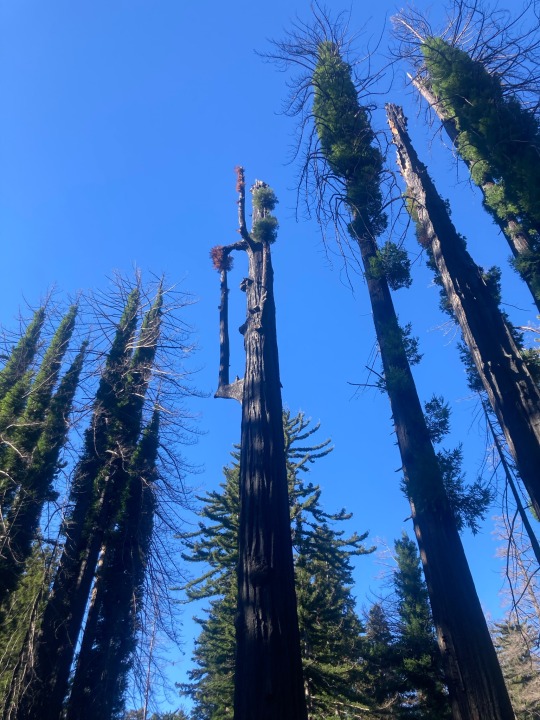
#this tree is a portal of some sort I’m sure#my photos#California#Santa Cruz County#Big Basin Redwoods State Park#woods
10 notes
·
View notes
Text
Saturday/Sunday
This weekend we are bikepacking for the first time in many years (Salt Point in 2021 I believe was the last time). We wanted to camp in Big Basin, but ultimately ended up at New Brighton again.
We got our gear packed up the night prior, and decided that I would ride black bike (for the wider tires and the front rack), and Nate would ride Mog.
Saturday: The weather was damp and cold in the morning when we started the ride around 7:30. Nate had a slow leak on his rear tire as we were going up Skyline right outside of the city, but fortunately we were able to continue on after he jammed a Dynaplug in there and hand-pumped it to a reasonable pressure.
The ride up to water tower (what is this thing?? for years I've been referring to it as a water tower but I don't think it is one) was hard, but the descent was harder. I hate that hill. Riding through Pacifica was quiet and cold and straightforward. Then we got to the part where there's a Taco Bell Cantina and the road goes into the woods and to the tunnel? And it said *Road Closed* but we asked the Caltrans employees if we could go through and they said, there's a fatal accident up ahead with lots of emergency vehicles and cranes, but you can probably go through. So we did this and wow I've never biked this section with no cars so it was a little bit of a luxury. Then we got through the tunnel and started seeing all the emergency vehicles and I refused to look directly at that area because it was tragic and scary. Nate said there was a car stuck in the cliff that the crane was gonna pull out. Anyway that was a dark moment of the ride.


A bittersweet stroke of luck
We then stopped at Montara Lighthouse, which is now a hostel. Didn't get a lighthouse stamp, but got a photo of the lighthouse which was cool.


The slope from the 1 down to this hostel was steep. I walked down and biked up.
Next we stopped in Half Moon Bay for bike shop and a breakfast/snack. First we went to Straight Wheel Cycling, where Nate refilled his rear tire sealant and bought some ride snacks (bonk breakers!). Then we went off in search of some coffee and pastries. I was grieving the loss of the Dunkin Donuts which I used to hit up every time I was in HMB (honestly, it was my sole reason to ever stop in HMB), but we got some unfresh pastries at Moonside and continued riding.


Hand pump air refill right before HMB; then SWC.
Our next stop was Pescadero (for bread), but before that, we encountered three small challenging hills. The first one was right after Tunitas Creek Road, where a small group of cyclists led by a long silver-ponytailed asian man (henceforth known as "the sensei") were passed by Nate. I passed 3 of the 4 riders (I never passed the sensei until he stopped to wait for his group). On the second hill, which came after a long descent that I took my sweet time on, I was passed momentarily by one of the riders in the sensei group, whom I then had to pass when he ran out of steam 1 ft into the climb, but then I was passed by the sensei, and all of us were passed by this time-trial bicyclist who was zooming. Nate was far ahead and could never be caught by the sensei. The last hill I don't remember anymore why it was challenging, but nobody passed me. Good riddance! I was grinding, though. The 46x17 on black bike is harder than my usual 47x19 spin on gangster.
Anyway, we finally got to bread, which I was surprisingly underwhelmed by. A billion other cyclists were there; fortunately we staggered our departures and kept going and never crossed paths. Next we stopped at Pigeon Point Lighthouse, which was only 5 miles away. I got my stamp and read a little bit about the lighthouse (1st order Fresnel lens) and we continued on.


Currently under renovation for the next two years, after which visitors can go to the top via neverending stairs!
I remembered this last stretch from Pigeon Point to Santa Cruz to be extremely boring and neverending, and I was correct. There were a few rolling hills that took a small amount of effort, but nothing to dread or fear. It was mostly the boredom that I dreaded. We also had a decent tailwind, which really helped.


Here you can see the weather starting to change from cool and gray to warm and sunny. I enjoyed the cool weather, but the sun was a nice change!
Finally we got to Santa Cruz and I insisted on going to the UCSC Arboretum. In order to get there, I had to climb up a 10% hill, which I physically could not do, and had to walk my bike. The rest of the route was a little hilly but I pushed through the pain. Oh I should also mention that my sitbones were in great agony at this point due to the weird shape of this saddle. Anyway I was very glad to get off my bike and walk around once we got to the Arboretum.


Recently I learned that the font of highway signs is called Highway Gothic.
After about an hour of me exclaiming loudly about how much I loved the Banksia in their collection, we left and continued biking to New Brighton State Beach. The ride was kinda interesting actually! We rode through a non-tourism/boardwalk part of Santa Cruz, where there were a lot of [thrift] shops, movie theatres, stores, restaurants, and other everyday city things, which I greatly enjoyed seeing. Then we biked on Capitola Ave where we admired the residential landscaping, and finally we arrived at Capitola Village which was tourism as usual, and then the campsite. After unpacking, we ate dinner at Margaritaville (same as last time in 2020) and then retired early at campsite.


Made it, with lots of daylight to spare / Next morning
Sunday: Got up and packed up around 8? The morning was once again damp with slight drizzle. We biked to Ugly Mug coffeehouse, where the proprietor noticed I was riding fixed and told me about a fixed gear team that does AIDS LifeCycle. Their coffee cake tasted weird (Nate said kelp).
From there on we rode up Soquel San Jose Road which was 11 miles of climbing, but after that, no more climbing! We switched bikes for about a mile during the climb, which was a great relief to me. I was grinding very slowly up the endless uphill curves. I hate when ascents are curvy and you can't see the crest. I like to be able to see the end.




Up and up and up
Then we reached the descent, where I went very slowly and never used my foot brake. Then we reached Lexington Reservoir, which I HATE! Because gravel is scary to me and I hate it. I keep imagining my tire slipping off a rock that moves causes me and my whole bike to just tip over. This would obviously not happen because I am not stationary, balancing on the corner of a rock. But I am still scared.






Anyway, the gravel also sucked because I felt every single god damn pebble thanks to this saddle that literally I later found out left me with blisters. BLISTERS!
Finally we got to Los Gatos and had lunch at LUNA Mexican Kitchen in Campbell, then rode to SJ Diridon station and went home. It was a little underwhelming but I was fucking tired so I did not care to be whelmed.


Billy Jones Wildcat Railroad in Vasona Lake County park; Del Monte water tower


Right next to the Caltrain: people playing basketball blasting Linkin Park; us stopping for snacks before getting on the train.
Also in checking my personal bests on Strava apparently I did not use Strava the last time I did this ride because I only see a record of the time I rode with Conrad. Anyway who cares I'm slow it's fine.
Strava there and back
0 notes
Text
Man missing for days found alive in California wooded area
A 34-year-old man was found alive in a California wooded area after he was heard calling for help Thursday, nine days after he was last seen, officials said.
Lukas McClish was last seen on the morning of June 11 in Boulder Creek — near Big Basin Redwoods State Park, about 14 miles north of Santa Cruz. He was reported missing on June 16, according to the Santa Cruz County Sheriff’s…
View On WordPress
0 notes